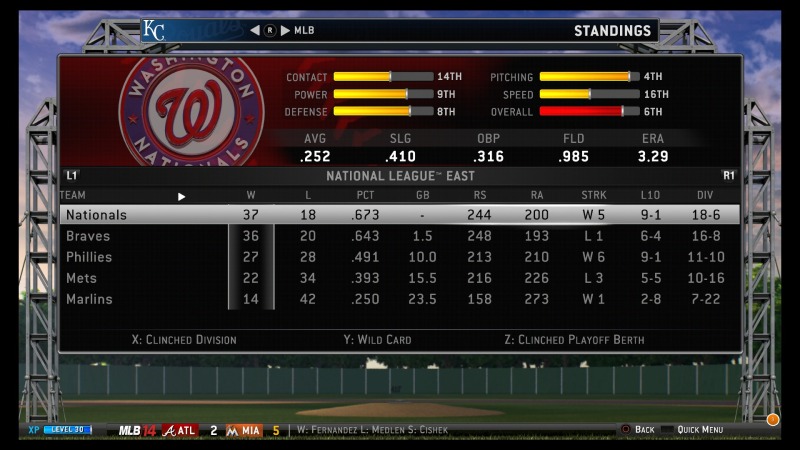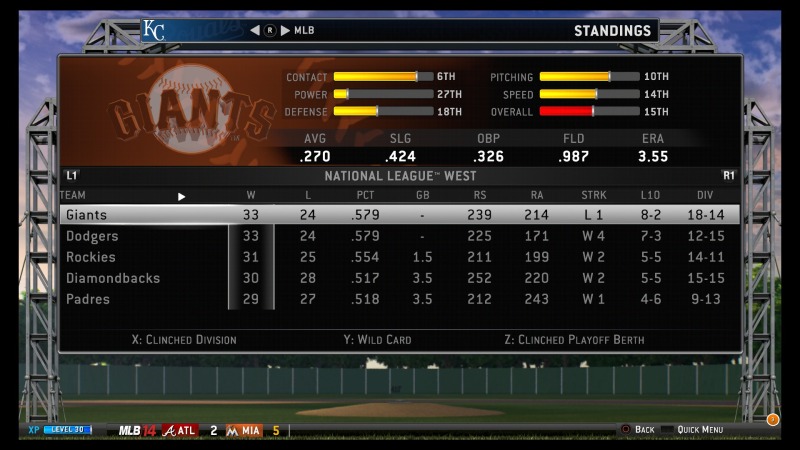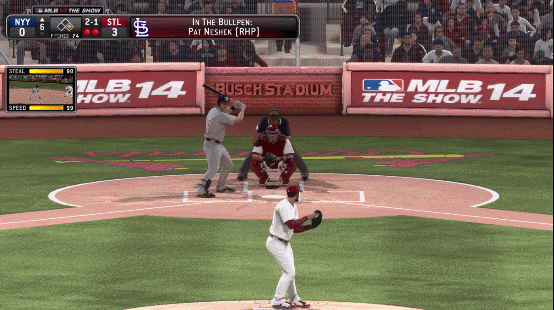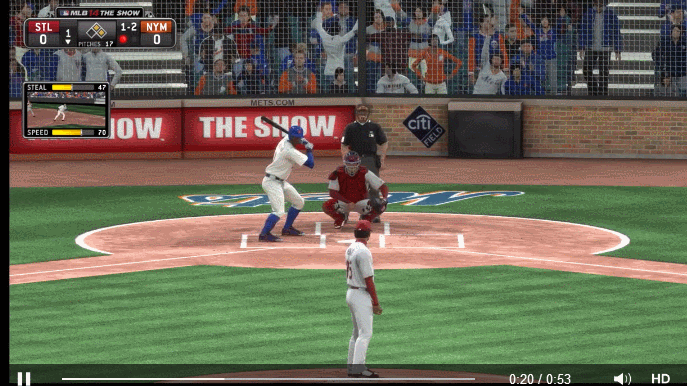Start from the Beginning – Episode 1: The History of the First Base War
Previous Episode: Trade Winds Part Two
In the dark future of 2099, robots playing baseball is commonplace. Pitches are thrown at 150 mph. Bats are laced with carbon fibers to increase home run distance. Laser weapons are mounted on arms to assist with breaking up double plays. These machines are designed with a certain brand of the sport in mind–one that fragile human flesh and bone would be unable to withstand. But it was more than that. Robot baseball was efficient. It was calculated. It was stripped of random chance and uncertainty with the virtual minds of the players guided by calculations beyond the comprehension of the human mind.
When the rogue AI K.I.R.K.G.I.B.S.O.N. selected six robot masters to send back to 2014, it did not anticipate these differences. It believed that the robot masters would be unstoppable. It failed to take into account…the human element. The fielders behind the robot pitchers would not be perfect. In fact, many of them would be quite terrible. The pitches the robot hitters faced in 2014 would be slow and unpredictable. And so, despite everything that had gone wrong with Mike Trout’s plan to save baseball, there was still hope.
As May came to an end, and faced with a mediocre start to the season, player/GM Pat Burrell made two dramatic moves to improve the Royals. Struggling prospect John Lamb was shipped out for the most corpulent pitcher in basebal, Bartolo Colon. And James Shields, whose ERA was beginning to affect the tides, was traded to the Cardinals for Matt Holliday and Carlos Martinez. This was a risky deal, as one of the six robot masters was playing for the Cardinals. There was a good chance Shields could put everything together again, but Burrell saw enough potential in Martinez that he didn’t believe St. Louis could end up winning the deal.
Martinez was immediately slotted into the rotation where James Shields had left off. Unlike in 2014-Prime, Carlos Martinez had started the season as a starter and was more than ready to start. He dominated in his first start against the Astros, leading the Royals to victory behind 8 strikeouts and 7 shutout innings.
Martinez wasn’t the only new player making an impact on the Royals. Colon didn’t offer as much of an upgrade over Vargas as Burrell hoped, but he kept the team in the first two games he pitched and let the revitalized offense blast their way to victory. And Matt Holliday quickly took up the mantle from Eric Hosmer as the hottest hitter on the team. After a torrid April, Hosmer had cooled and fallen out of the leaderboards. But Holliday, spurred by St. Louis dropping him in favor of a younger outfield, went on a hot streak as soon as he was acquired and immediately found himself a place on the AL Leaderboards.
Over on the other side of the ball, Strike-O-Matic found himself fourth in the league in ERA behind Jon Lester, A.J. Griffin, and Wei-Yin Chen. This was a strange assortment of company, but then again baseball had been forever changed by the early introduction of robotic players.
Notably, none of the AL robot masters appeared in the leaderboards. Stubby Candyman, Flash Money, and Preacher Cobra all recovered after experiencing a difficult April, but none of them had elevated their numbers to what was expected. This was not so true of the NL robot masters, who had claimed the #2 spots among the OPS and ERA leaders.
Around the league, the divisional races were beginning to take shape. It was only a third of the way through the season, but there was plenty to glean from the almost 60 games each team had played.
In the NL East, the fate of the division had already boiled down to two strong competitors and a field of also-rans. The Nationals, led by the excellent pitching of Stephen Strasburg, Jordan Zimmerman and Doug Fister, had a one game lead on the hard-hitting Dixie Dirtbag and the Atlanta Braves. The Phillies played at contention, but were already ten games out of first place after a six game winning streak. The Mets had given up and the Marlins were up to their usual tricks, lining Jeffery Loria’s wallet first and competing a distant second.
The only bright spot for the Marlins was fireballing Jose Fernandez, who in 2014-Prime was shut down after only 51 innings with a torn UCL. Fernandez was seventh in the league with a 2.21 ERA, though thanks to his teammates he’d only managed a rather unimpressive 3-6 win-loss record.
The Royals probably should have tried to trade for Jose Fernandez.
The NL Central continued to be a one-team race. Bolstered by robot master PrimeTime Moose, the Cardinals were trying to eliminate their competition by the All-Star break. With the most runs scored in the league, and the second fewest runs allowed, they’d established control of the division by the end of May. However, they followed one questionable decision with another. Once they acquired James Shields for Holliday and Martinez, they made another trade that was even more puzzling:
Michael Wacha, one of the most promising young pitchers in the Major Leagues, was shipped out in exchanged for the aging Adam Lind and Mark Buehrle. Why would the Cardinals do this? Well…
The National League West, meanwhile, was a vicious dogfight with every team within four games of the lead. Kershaw’s Dodgers and Posey’s Giants led the pack, but a hot streak or a couple cold streaks were enough to change everything.
The Arizona Diamondbacks had expected robot master Dubya Bush to emerge as the ace of the pitching staff, but instead that responsibility fell on the back of a resurgent Barry Zito. The veteran lefty was having the best year since his time in Oakland, with a 2.54 ERA and a 7-2 record.
Bush, meanwhile, was struggling to be more than a middle-of-the-rotation innings eater. His extreme right submarine style wasn’t fooling the hitters as expected, and he repeatedly failed to live up to his expectations.
In the American League East, the Red Sox had emerged as the division leader behind, unsurprisingly, the bat of David Ortiz and the arm of Jon Lester. But the race was hardly decided, with the Blue Jays, Yankees, and Rays not too far behind.
The Yankees’ very own robot master, Flash Money, was finally pulling everything together. His average was over .270 with a handful of HR and 2b, but most importantly he was finally using his most valuable skill: his 99-rated speed. After barely getting on base or running in April, he had 13 SB in May, bringing his total to 20.
The Kansas City Royals were mounting their offensive on the AL Central, but they still hadn’t quite caught up with the Cleveland Indians. Yes, in the alternate version of 2014 in which literally nothing was changed about the Cleveland Indians, they had a 1.5 game lead on the American League Central.
Unexpectedly, the Seattle Mariners had emerged to become the team to beat in the NL West. They weren’t being carried by any particular excellent performances, just an all-around consistency throughout the lineup and rotation that left very few holes for their opponents to exploit. This was hardly what anyone expected from Seattle, a team that should have been only able to win only with a herculean effort from Felix Hernandez and Robinson Cano. But several players–Justin Smoak, Mike Zunino, Hisashi Iwakuma, Kyle Seager, and the unretired Ken Griffey Jr.–emerged as a strong supporting cast. And closer Fernando Rodney didn’t allow a run all season until the last day of may, racking up the most saves in the American League.
Even more surprising than the Seattle Mariners were the Houston Astros. Despite barely running a major league team out on the field, they were within striking distance of .500. It was going to take a miracle for them to pull themselves into contention, but something strange was going on in Houston for them to get even this close to respectable.
As June began, the Royals weighed the request of Alcides Escobar to be traded to the Astros, especially after he offered to remain on as their sabermetrician even if he played for another team. But that was hardly their most pressing concern. The first series of the month was an interleague match-up with the MLB-leading St. Louis Cardinals. This would not only be the Royals most challenging series to date, but it would match up Strike-O-Matic against the next of the robot masters and the NL’s second best pitcher, PrimeTime Moose.
















































we want beau mills
Wacha traded as well? When did the GM’s phone get routed through the Cardinal dugout?
Alt-2014 would be looking ugly for the Cardinals future if I hadn’t given them a 99 rated clone of Mike Mussina.